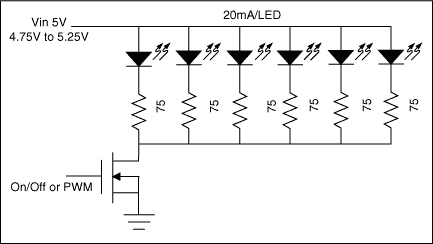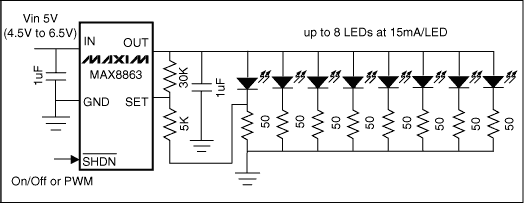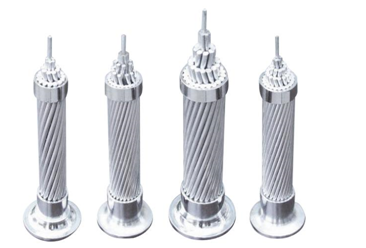Since the invention of white LEDs a few years ago, the application of white LEDs has steadily developed. Compared with fluorescent lamps, it has the advantages of simple use and low cost. Compared with incandescent lamps, it can provide light that is closer to white. Therefore, its usage has shown a steadily increasing trend in recent years and is widely used in handheld products Used as flash, display backlight, etc. Of course, there are some technical problems to be solved for white LEDs in practical applications.
The most obvious problem in choosing white LEDs is poor product matching. According to the typical specifications of white LEDs, the minimum value of the forward voltage when the current is 20mA is 3.0V, the typical value is 3.5V, and the maximum value is 4.0V. Obviously, the voltage regulator source is not a reasonable solution. Driving each LED with the same current can achieve uniform brightness, but the cost is high. In many applications, the LED is simply driven with a fixed bias voltage and ballast resistance, as shown in Figure 1.

Figure 1. Most applications simply use a fixed bias voltage (5V in this example) and a ballast resistor (75Ω in this example) to obtain an approximately matched white LED brightness.
Designing a circuit according to Figure 1 can usually get a fairly good brightness match. But for users of mass production, the same batch of products has fairly consistent characteristics, but the consistency between batches is poor. This requires testing each new batch of LEDs and configuring ballast resistors for them. If there are multiple LED suppliers, the problem will be more serious. In order to describe the above problems in detail, we selected the LEDs of three manufacturers (represented by A, B, and C, respectively) according to the circuit shown in Figure 1 for the following tests: The LED labeled A is selected from the first-level white LED suppliers The LED labeled B is selected from secondary white LED suppliers, and the LED labeled C is a cheap LED purchased from the electronic accessory market. The test results are shown in Table 1.
Table 1. To evaluate the production capacity of the circuit in Figure 1, we tested white LEDs provided by three different manufacturers. From the test results, the consistency of LEDs of different brands is poor, with a deviation of 3.27mA from the standard average current.

It can be seen from Table 1 that the LEDs of the same manufacturer are well matched, especially the products from larger suppliers (A and B LEDs). As expected, the consistency of LEDs from supplier C in different packages is poor. The average mean square error of the LED currents of the three manufacturers is 0.54mA.
As can be seen from the "Average" column of Table 1, the consistency of LEDs provided by different manufacturers is poor, the LED sink current provided by manufacturer A is the largest (average 24.6mA), and the LED current provided by manufacturer B is the smallest (average 18.3mA) . When using the same bias voltage and the same ballast resistance, the white LEDs of different manufacturers have large current differences, and the mean square error is 3.27mA.
Adjusting the current of each LED individually or adjusting the current of at least one of the LEDs can improve the consistency of different manufacturers or different batches of LEDs from the same manufacturer, but this requires quite expensive chips. In products with stringent cost requirements, low-dropout linear regulators (LDOs) can be used to improve the consistency of LEDs without the need to select ballast resistors with different resistance values. The specific circuit is shown in Figure 2. The LDO in the figure works in the voltage stabilization-steady current mode, and automatically adjusts the bias voltage according to the change of the forward voltage of an LED.

Figure 2. Add a low-cost LDO to obtain an automatically adjustable bias voltage, effectively improving the matching of white LEDs from different batches and different manufacturers.
In order to assess the performance of the circuit in Figure 2, we tested the three LEDs A, B, and C according to the circuit connection in Figure 2, and the test results are shown in Table 2. From Table 2, it can be calculated that the consistency of the LED current of the same manufacturer slightly decreases (the result obtained in Figure 2 is 0.77mA and the result obtained in Figure 1 is 0.54mA), but the consistency of the LED current of different manufacturers has been greatly improved. The mean square error is reduced from 3.27mA to 0.96mA.
Table 2. In order to evaluate the performance of the circuit in Figure 2, we tested the same three groups of white LEDs. As can be seen from Table 2, the consistency of LEDs provided by different manufacturers has been improved, which deviates from the standard value of 3.27mA as shown in Table 1. Reduced to 0.96mA.

The circuit in Figure 2 needs to select an LDO with an external voltage adjustment pin, such as the MAX8863, whose feedback threshold is 1.25V (VSET). Selecting SOT23 packaged LDO can improve the cost performance of the system, because most SOT23 packaged LDOs have related off control, thus eliminating the N-channel MOSFET that controls LED on / off or PWM brightness adjustment in the circuit of Figure 1. In addition, LDO also has a wider input voltage range, which can provide a higher power supply rejection ratio (PSRR) when sharing the same 5V power supply with other circuits. In addition, the LED provided by manufacturer A will not operate in a "hot" state. No need to think too much about heat dissipation.
The circuit in Figure 3 is a modification of the circuit in Figure 2. The current of each LED is 15mA, which is suitable for backlight requirements of portable products. MAX8863 can drive 8 LEDs, each LED current is 15mA. When the LED forward voltage is low, or the current of the ballast resistor is less than 15mA, the allowable input voltage is lower.

Figure 3. The MAX8863 LDO can drive 8 LEDs with a current of 15mA per LED. It can provide better brightness matching for different manufacturers and different batches of LEDs.
A Aluminum Stranded Conductor(AAC)is a bare conductor (non-insulated conductor) applicable for electrical power transmission in modern overhead power line with various voltage levels. It has cost and weight advantages while comparing to copper wires and cables. And it is as simple as installing copper wires. We have common aluminum conductor, rare earth aluminum stranded conductor with both single layer or multi layer construction.
Main advantages
Attractive price with high standard quality
Higher strength, good electrical conductivity
Simple structure, convenient installation and maintenance


Product features
Range:16 to 800 sq mm²
Voltage Rating: Up to 500kV
Delivery length:800-4000m
Standard: IEC61089
|
Cross-section Area (mm²) |
Core No./Diameter (mm) |
Outer Diameter (mm) |
Min. DC Resistance under 20℃ (Ω/km) |
Calculated Tensile Force
|
Calculated Weight (kg/km) |
Min. Delivery Length (m) |
Continual Current-Carrying (A) |
|
16 |
7/1.70 |
5.10 |
1.8020 |
2840 |
43.5 |
4000 |
111 |
|
25 |
7/2.15 |
6.45 |
1.1270 |
4355 |
69.6 |
3000 |
147 |
|
35 |
7/2.50 |
7.50 |
0.8332 |
5760 |
94.1 |
2000 |
180 |
|
50 |
7/3.00 |
9.00 |
0.5786 |
7930 |
135.5 |
1500 |
227 |
|
70 |
7/3.60 |
10.80 |
0.4018 |
10590 |
195.1 |
1250 |
284 |
|
95 |
7/4.16 |
12.48 |
0.3009 |
14450 |
260.5 |
1000 |
338 |
|
120 |
19/2.85 |
14.25 |
0.2373 |
19420 |
333.5 |
1500 |
390 |
|
150 |
19/3.15 |
15.75 |
0.1943 |
23310 |
407.4 |
1250 |
454 |
|
185 |
19/3.50 |
17.50 |
0.1574 |
28440 |
503.0 |
1000 |
518 |
|
210 |
19/3.75 |
18.75 |
0.1371 |
32260 |
577.4 |
1000 |
575 |
|
240 |
19/4.00 |
20.00 |
0.1205 |
36260 |
656.9 |
1000 |
610 |
|
300 |
37/3.20 |
22.40 |
0.09689 |
46850 |
820.4 |
1000 |
707 |
|
400 |
37/3.70 |
25.90 |
0.07247 |
61150 |
1097.0 |
1000 |
851 |
|
500 |
37/4.16 |
29.12 |
0.05733 |
76370 |
1387.0 |
1000 |
982 |
|
630 |
61/3.63 |
32.67 |
0.04577 |
91940 |
1744.0 |
800 |
1140 |
|
800 |
61/4.10 |
36.9 |
0.03588 |
115900 |
2225.0 |
800 |
1340 |
Application
This cable is widely used in overhead electrical power transmission lines with rated voltage up to 500kV. It is also applicable for laying across the rivers, valleys and other places where special geographical features exist.
FAQ
Q: Are you a factory or trading company?
A : We are a manufacturer. We are professional in
developing and producing electrical wires and cables since 2001.
Q: Can I visit your factory?
A :Yes! You are welcome to visit our factory for further detail check.
Our factory is located in Minqing,Fujian.You could choose to fly to Xiamen/Fuzhou International airport. And tell us your flight No. We will arrange to pick you up if you like.
Q: May I buy samples from you?
A: Yes! You are welcome to place sample order to test our superior quality and services.
Q: Can you put my brand name (logo) on these products?
A: Yes! Our factory accepts to print your logo on the products.
Q: May I know the status of my order?
A: Yes .The order information and photos at different production stage of your order will be sent to you and the information will be updated in time.
As a professional manufacturer, we also welcome OEM order according to relevant standard as your request. Please feel free to contact us if you are inquiry electrical wires and cables.
Aluminum Stranded Conductor
Aluminum Stranded Conductor,Aluminum Stranding Conductor,Overhead Aluminum Stranded Conductor,Overhead Aluminum Stranded Conductor
Smartell Technology Co.,Ltd , http://www.liencable.com
